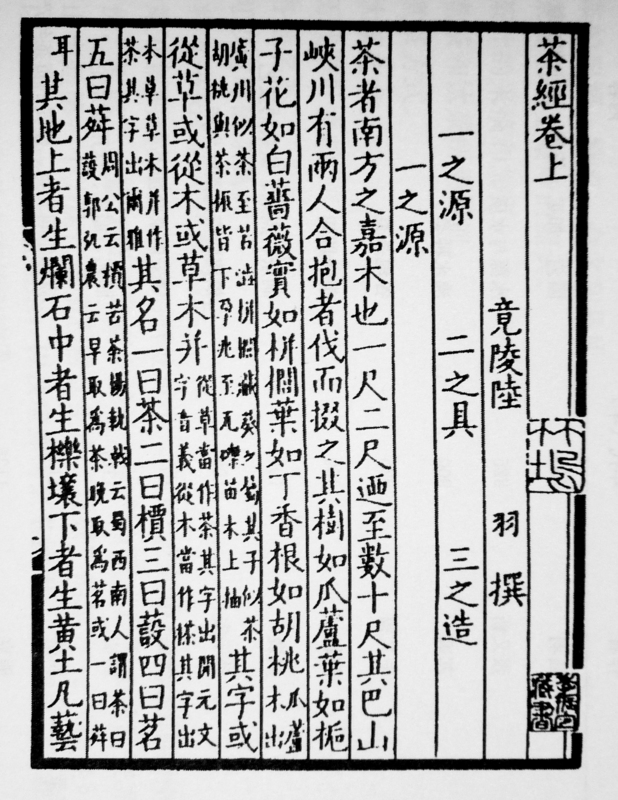The Tang Dynasty: The Spread of Tea (618 - 907)
Lu Yu was raised by Buddhist monks during the Tang dynasty. At this time, Buddhists was pioneering tea culture (Hinsch 55). Lu applied his extensive childhood knowledge of tea in his book The Classic of Tea, thus becoming the foremost authority on the subject. The book goes into great detail about how tea should be harvested, processed, prepared and served. All the tools were specifically chosen to best compliment the tea.
Lu discusses no less than sixteen tools to be used in the processing of tea leaves. He first specified that pickers must use loosely woven bamboo strip baskets to hold the leaves. They were designed to allow for ventilation during this process. The stove, wok, and steamer were used to steam and dry the leaves. The stove should be used to burn logs without a smokestack or a chimney and the steamer should be placed above the wok which is filled with water. The mortar and pestle are used to grind the leaves. Because they will absorb the tea flavors, the mortar and pestle should be used exclusively for tea. Molds are to be used to press the freshly steamed leaves into cakes. Lu writes about the table another tool in the production process. He says the the table should be sturdy to withstand the pressure needed to create the cakes. He even suggests that the legs be partially buried in the ground to provide more stability. Stone tables are preferred but wooden tables made from pagoda or mulberry trees are also acceptable. The table should also be covered with a sheet so all the cakes may be picked up and moved at once when pressing is completed. A sieve made from bamboo strips is needed to separate tea leaves, and awl is utilized to punch holes in the cakes so they may be put on a string for easier transportation. Lu specifies that bamboo twine needs to be used for these cake “necklaces”.
For drying cakes, Lu suggests using a drying (fire) pit that is 2 feet deep along with 2 feet high above ground walls. Above the pit will be a a drying rack that is two tiered and one foot tall to hold the bamboo skewers that are strung with tea cakes. Wetter cakes should be placed on the bottom rack and dryer cakes on the top (Tea Sutra 33-35).
Lu’s descriptions of the tools for preparing tea are even more intricate. The brazier should be bronze, clay or iron a quarter inch thick at the rim and thinner in the body. A charcoal basket hold the coal. Lu specifies this container to be hexagonal, fourteen inches high and seven inches in diameter. The hexagonal charcoal stoker and breaker are used to stoke and break up coals while tongs are used to pick up coals. The brazier, stoker, and breaker can be intricately decorated but the tongs are should be plain iron or copper sticks. The cauldron is a cast iron or silver kettle. The inside should be made smooth to make cleaning easier but the outside should be rough to allow the pot to heat up faster and should be structured so the heat is concentrated in the center. This will allow tea powder to better dissolve in the water. Lu writes that silver is ideal as it imparts little flavor on the tea but ceramic and stone are also acceptable kettle materials, though they won’t be as durable. After the water has been boiled, the kettle should be placed on a folding stand and bamboo tongs are used to roast tea cakes over the fire. The cakes should then be placed in envelopes of thick paper to preserve their flavor (Tea Sutra 39-40).
A grinder should be used to grind the cakes into a powder to be added to the water. Mandarin orange timber, pear, mulberry, paulownia, and Tricuspid cudrania are all acceptable materials for the grinder. Lu writes about fourteen more tools used in the remaining stages of tea preparation including a tea powder sieve, ladle, salt dish, and teal bowls. During the Tang and Song dynasties, tea bowls were the popular vessel for serving tea.
A lot of the rules and traditions surrounding tea may seem arbitrary and pretentious, but generally, Lu’s suggestions on teal tools are practical. For example, including the table as a tool initially seems out of place but it quickly becomes clear that table strength is an important consideration. On the right is an image of a set of royal tea tools from the Tang dynasty. These tools from top left to right are a charcoal basket, tea powder sieve and caddy, stove, (bottom left to right) tea leaf box, a grinder, and a salt plate. This set was discovered at Famen temple and is significant because this is the oldest and most complete tea set archaeologists have found to date.


